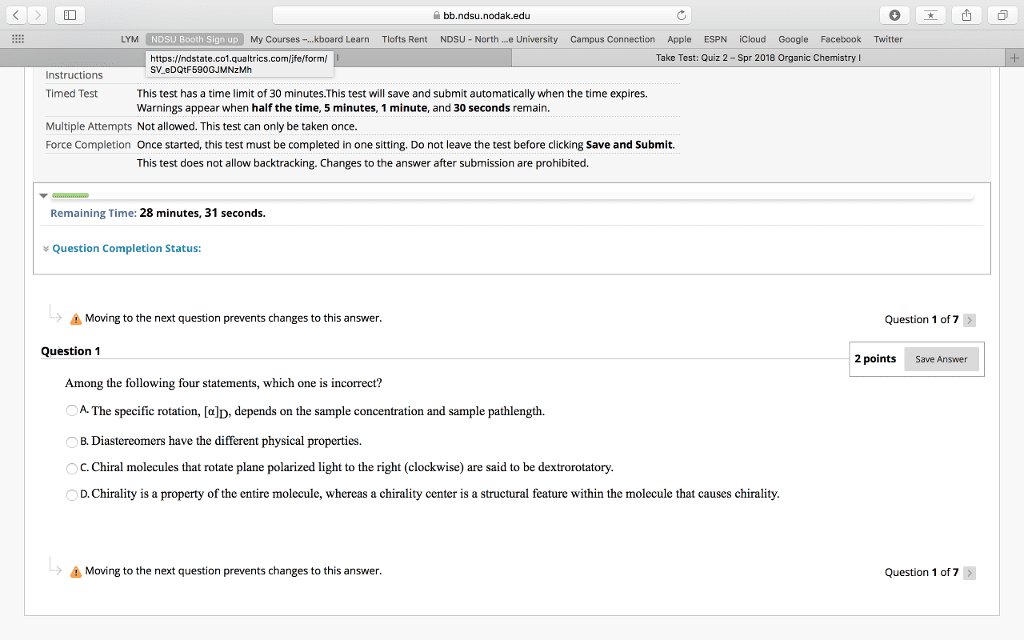CHM136H1 Study Guide - Midterm Guide: Ionic Bonding, Equilibrium Constant, Pi Bond
University of Toronto
St. George
CHM136H1
Introductory Organic Chemistry I
Winter 2018
Term Test 1
Prof: Scott Browning
Exam Guide
Table of Contents:
Bonding in Organic Molecules
VSEPR Theory
Polar Bonds and Resonance
Acid-Base Reactions
Alkanes and Cycloalkanes
Conformations in Alkanes and Cycloalkanes
Angle Strain and Isomerism in Cycloalkanes
Isomerism and Substituents
Stereochemistry
Chirality and Fischer Projections
Prochirality
Overview of Organic Reactions
The Reaction Mechanism
Activation Energy and Degrees of Unsaturation
Bonding in Organic Molecules
The Atom: Schrodinger Model (1926)
•Every atom has a series of atomic orbitals (mathematical functions having wave
characteristics)
o1s, (2s, 2p), (3s, 3p, 3d), …
oEach describes a volume of space where an electron is likely to be found
•2p orbitals all have the same shape, the only difference is the orientation
•Model predicts that the s, p, and d orbitals have different energies
oEach type of subshell has degenerate orbitals (i.e. they have the same energy)
•Electrons in orbitals:
oTwo electrons per orbital with opposing spin
oOrbitals of lower energy fill first
oIf one or more orbitals of equal energy are available, electrons will half-fill each
orbital before pairing in each orbital
•A node – describes a space where an electron will never be found (probability of finding
an electron in a node is zero)
Bonding
•Bonds form because the resulting molecule has lower energy (more stable) than the
atoms apart
•Ionic bonding: electrostatic forces of attraction between oppositely charged ions
• Ionic solids form because oppositely charged ions are attracted to each other in all
directions (non-directional bond)
o Packing: when cations are surrounded by anions and vice versa in a solid
• Covalent bonding: electrons shared between atoms
o The smaller the separation, the stronger the bond, until nuclear-nuclear
repulsions become too large
Organic Chemistry
• The study of compounds containing carbon
• First defined in the 1770s:
o Compounds from living organisms arise from the “vital force” of life – vitalism
(1828) – this theory was disproved in 1828 when Wöhler made urea (found in
urine) from an inorganic salt (ammonium cyanate)
o Organic: sugars, plant oils, starches, protein, urea, DNA
o Inorganic: salts, rocks, gases
• What’s so special about carbon?
• Carbon can form up to four bonds
• Makes strong covalent bonds
• Can make long chains or rings
Structure and Bonding
• Shapes of organic chemistry:
o Linear (e.g. C2H2) – all atoms lie along a line
o Planar (e.g. C2H4) – all atoms lie in the same plane
o Tetrahedral (e.g. CH4) – atoms form a tetrahedron
• The above shapes recur in all organic molecules
• Drawing organic molecules:
o VSEPR model
Lines indicate a bond in the plane
Wedges indicate a bond sticking out in front of the plane
Dashed wedges indicate a bond sticking back behind the plane
o Lewis structure or Kekulé structure
Essentially VSEPR, except without wedges or dashed wedges
o Condensed structure
Composed of only letters and numbers
Only for relatively simple molecules
Rings become challenging with condensed structure

34
CHM136H1 Full Course Notes
Verified Note
34 documents

